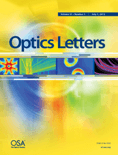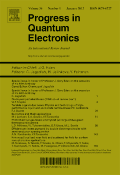
Optics Continuum
Scope & Guideline
Advancing Knowledge in Optics and Photonics
Introduction
Aims and Scopes
- Advanced Optical Engineering:
Research in this area includes the design and development of optical systems, components, and devices, such as lasers, sensors, and imaging systems, which are crucial for various applications in science and industry. - Quantum Optics and Photonics:
This scope covers studies on quantum phenomena in optics, including quantum key distribution, quantum imaging, and the manipulation of light at the quantum level, contributing to the development of secure communication and advanced imaging techniques. - Nonlinear Optics:
Investigations into the nonlinear interactions of light with matter, including phenomena such as four-wave mixing, soliton dynamics, and supercontinuum generation, are essential for developing new optical materials and technologies. - Optical Sensing and Measurement:
This area focuses on the development of optical sensors for various applications, including environmental monitoring, biomedical diagnostics, and industrial applications, emphasizing the integration of advanced materials and technologies. - Metamaterials and Nanophotonics:
Research in this domain explores the unique optical properties of metamaterials and nanostructures, leading to innovations in imaging, sensing, and information processing. - Imaging and Spectroscopy Techniques:
The journal highlights advancements in optical imaging and spectroscopy methods, including digital holography, phase retrieval, and hyperspectral imaging, which are vital for material characterization and biomedical applications. - Computational and Theoretical Optics:
This scope includes the development of algorithms and models to simulate optical phenomena, providing insights into complex optical systems and guiding experimental research.
Trending and Emerging
- Machine Learning and Artificial Intelligence in Optics:
The integration of machine learning and AI techniques in optical research is becoming increasingly prominent, enabling advancements in image processing, sensor technology, and optical system design. - Terahertz Technology:
Research into terahertz (THz) systems, including imaging, sensing, and communication, is rapidly growing, driven by its potential applications in healthcare, security, and telecommunications. - Integrated Photonics and Silicon Photonics:
The development of integrated photonic devices, particularly using silicon-based technologies, is trending due to its scalability and potential for high-density information processing and communication. - Quantum Technologies and Quantum Information Science:
There is a notable increase in research focused on quantum technologies, including quantum communication, quantum sensing, and quantum imaging, reflecting the growing interest in harnessing quantum phenomena for practical applications. - Advanced Metamaterials and Plasmonics:
The exploration of metamaterials and plasmonic structures is gaining momentum, with applications in sensing, imaging, and electromagnetic manipulation, driven by their unique optical properties. - Biomedical Optics and Photonics:
Research in biomedical applications of optics, including imaging techniques and diagnostic tools, is on the rise, particularly in the context of personalized medicine and non-invasive procedures. - Optical Neural Networks and Photonic Computing:
The emergence of optical neural networks and photonic computing is gaining attention, as researchers explore the potential of light-based systems for efficient computation and data processing.
Declining or Waning
- Classical Optical Communication Systems:
Research related to traditional optical communication systems, such as those based on standard fiber optics without advanced modulation techniques, is appearing less frequently as the focus shifts towards more complex, high-capacity systems. - Basic Optical Materials Studies:
Basic studies on conventional optical materials without significant innovation or application focus are declining, as researchers are increasingly prioritizing advanced materials and their applications in modern optics. - Static Imaging Techniques:
Traditional static imaging methods are being overshadowed by dynamic and real-time imaging approaches, such as those utilizing machine learning and advanced computational techniques. - Fundamental Nonlinear Optical Effects:
While nonlinear optics remains a vital field, research specifically focused on fundamental effects, without practical applications or advancements in technology, seems to be decreasing.
Similar Journals

OPTICS LETTERS
Exploring New Frontiers in Light and MatterOPTICS LETTERS is a premier academic journal published by the Optica Publishing Group, dedicated to advancing the field of optics and photonics. Since its inception in 1977, it has maintained a strong reputation for publishing high-impact research, holding a distinguished Q1 category ranking in Atomic and Molecular Physics, as well as Optics, making it a vital resource for researchers and professionals alike. With an impressive Scopus rank of #55 out of 224 in its field, OPTICS LETTERS continues to shape the discourse and innovation in optical science. Authors benefit from its extensive international reach, while readers gain access to cutting-edge studies that address both theoretical and applied aspects of optics. Although the journal currently does not offer open access options, its rigorous peer-review standards ensure that every publication meets the highest academic criteria, making it an essential journal for anyone looking to stay at the forefront of optical research.

Opto-Electronic Advances
Shaping the Future of Interdisciplinary ScienceOpto-Electronic Advances is a premier open-access journal published by the Chinese Academy of Sciences' Institute of Optics & Electronics, dedicated to advancing the fields of optics and electronic engineering. Established in 2018, this journal quickly ascended to a Q1 ranking across multiple categories including Atomic and Molecular Physics, Electrical and Electronic Engineering, and Electronic, Optical and Magnetic Materials, showcasing its impact and relevance in the scientific community. With an impressive Scopus ranking placing it in the top percentiles for critical fields such as Engineering, Materials Science, and Physics, Opto-Electronic Advances provides a platform for researchers to publish their cutting-edge findings and foster dialogue in an increasingly interdisciplinary area of study. The journal emphasizes innovative research that contributes to practical applications and theoretical frameworks in its domain, making it an invaluable resource for academicians, industry practitioners, and students alike. Embrace the future of opto-electronic research with Opto-Electronic Advances, which has been fully open access since 2021, ensuring that knowledge is widely disseminated without barriers.

Chinese Optics Letters
Illuminating discoveries in optics and engineering.Chinese Optics Letters is a prestigious academic journal published by Chinese Laser Press, dedicated to advancing the fields of atomic and molecular physics, optics, as well as electrical and electronic engineering. Since its inception in 2003, this journal has become a significant platform for researchers and professionals to disseminate innovative findings and foster collaboration within these rapidly evolving disciplines. With a commendable Q2 ranking in leading categories including Atomic and Molecular Physics and Electronic, Optical and Magnetic Materials, it ranks favorably within the Scopus database, with notable positions in both engineering and materials science sectors. The journal is headquartered in Shanghai, China, and while additional open access options are not specified, it remains a vital resource for those committed to pushing the frontiers of optical research and applications. As we approach 2024, Chinese Optics Letters continues to play an essential role in shaping scholarly discourse and technological advancement in optics.

Advanced Photonics
Exploring the Boundaries of Light and InnovationAdvanced Photonics, published by SPIE-SOC PHOTO-OPTICAL INSTRUMENTATION ENGINEERS, is a prestigious open-access journal dedicated to cutting-edge research in the fields of photonics, optics, biomedical engineering, and material science. Since its inception in 2019, this journal has successfully established itself in the top quartile (Q1) of various categories, including Atomic and Molecular Physics, Biomedical Engineering, and Electronic, Optical and Magnetic Materials, showcasing its critical role in advancing knowledge and innovation within these disciplines. With impressive Scopus rankings—#8 in Biomedical Engineering, #7 in Atomic and Molecular Physics, and #10 in Materials Science—Advanced Photonics serves as an essential platform for researchers, professionals, and students alike, offering a wealth of accessible scholarly content to keep pace with rapid technological developments. The journal not only fosters collaboration and knowledge dissemination within the global scientific community but also emphasizes the importance of open access to ensure that groundbreaking research benefits society as a whole.

PROGRESS IN QUANTUM ELECTRONICS
Unveiling Breakthroughs in Quantum ElectronicsPROGRESS IN QUANTUM ELECTRONICS, published by PERGAMON-ELSEVIER SCIENCE LTD, is a premier international journal that serves as a critical forum for the dissemination of high-quality research in the fields of atomic and molecular physics, electrical engineering, and materials science. With its esteemed Q1 category ranking in several disciplines, including Atomic and Molecular Physics, Electrical and Electronic Engineering, and Electronic, Optical and Magnetic Materials, this journal commands a high impact factor and is recognized for its rigorous peer-review process. Established in 1969 and evolving through various phases, the journal currently compiles cutting-edge research that drives advancements in quantum technologies. Researchers, professionals, and students alike are invited to explore a wealth of knowledge and stay updated on pioneering developments in quantum electronics, enhancing their understanding and contributing to the progression of this dynamic field.

Optica
Driving advancements in atomic physics and optics.Optica is a premier open-access journal published by the Optica Publishing Group, designed to disseminate high-quality research across the fields of Atomic and Molecular Physics and Optics. Since its inception in 2014, it has established itself as a vital resource for the scientific community, as evidenced by its impressive Q1 rankings in both relevant categories in 2023 and its notable positions in the Scopus rankings—#9 in Atomic and Molecular Physics and #13 in Materials Science. Featuring cutting-edge research from leading experts, Optica aims to foster innovation and collaboration by providing unrestricted access to groundbreaking discoveries and advancements. Researchers, professionals, and students alike will find invaluable insights and trends that drive the ever-evolving scope of optical science and materials technology. With its commitment to open access, Optica ensures that knowledge is accessible, empowering the global community of scientists and researchers to embark on new explorations.

JOURNAL OF RUSSIAN LASER RESEARCH
Empowering Researchers with Groundbreaking InsightsThe Journal of Russian Laser Research, published by Springer, stands as a vital resource for researchers and professionals in the fields of atomic and molecular physics, as well as optics and engineering. With its ISSN 1071-2836 and E-ISSN 1573-8760, this journal has been disseminating groundbreaking research since its inception in 1994, with a dedicated focus on the advancement of laser technologies and their applications. While it currently holds a Q4 classification in both Atomic and Molecular Physics and Engineering categories, its commitment to fostering novel insights and innovative methodologies positions it as a promising platform for emerging studies within these disciplines. Although the journal does not offer open access options, it continues to draw attention with a growing citation index. By publishing diverse research articles, reviews, and critical discussions, the Journal of Russian Laser Research not only enriches academic literature but also serves as a stepping stone for students and professionals seeking to deepen their understanding of laser science and its myriad applications.

OSA Continuum
Empowering Open Access to Cutting-Edge ResearchOSA Continuum, published by the Optica Publishing Group, is a distinguished open access journal dedicated to advancing research in the realms of Atomic and Molecular Physics, Optics, and Electronic and Electrical Engineering. Since its inception in 2018, this journal has rapidly positioned itself as a significant platform for disseminating cutting-edge findings, achieving impressive Scopus rankings with a 61st percentile in Electrical and Electronic Engineering and 57th in Atomic and Molecular Physics. Based in the United States, the journal not only promotes scholarly dialogue among researchers and professionals but also plays a crucial role in bridging theoretical advances with practical applications in optical and material sciences. Its open access format ensures broader visibility and accessibility of research outputs, fostering innovation and collaboration across disciplines. With its ongoing commitment to excellence, OSA Continuum is crucial for anyone involved in these dynamic fields.

OPTICA APPLICATA
Exploring the Frontiers of Optics and ApplicationsOPTICA APPLICATA, published by Wroclaw University of Science and Technology, is a crucial platform for advancing knowledge in the fields of Atomic and Molecular Physics and Optics. With an ISSN of 0078-5466 and an E-ISSN of 1899-7015, this journal serves as a vital resource for researchers, professionals, and students seeking to explore the latest developments and applications in optical science and engineering. Although currently categorized in the fourth quartile in both Atomic and Molecular Physics and Electronic, Optical and Magnetic Materials, its commitment to publishing high-quality research articles, reviews, and technical notes remains unwavering. The journal covers diverse topics from practical applications to theoretical insights and fosters a collaborative environment for global contributors. While it does not offer an open access option, the journal is accessible through university libraries and institutional subscriptions. With an eye towards bridging academic research with real-world applications, OPTICA APPLICATA is well-positioned to influence advancements in photonics and materials science through ongoing issues from 1988 to 2024.

Nonlinear Optics Quantum Optics-Concepts in Modern Optics
Unraveling the Mysteries of Light through InnovationNonlinear Optics Quantum Optics-Concepts in Modern Optics is a specialized journal published by OLD CITY PUBLISHING INC, focusing on the forefront of research in nonlinear optics and quantum optics. With an ISSN of 1543-0537 and an E-ISSN of 1944-8325, this journal serves as a pivotal platform for the dissemination of innovative concepts and findings in modern optics, significant for both theoretical exploration and practical applications. Established in 2003, the journal's scope encompasses critical areas such as atomic and molecular physics, optical materials, and instrumentation, attracting submissions from a diverse range of interdisciplinary fields. While the journal currently maintains a Q4 ranking in several categories, it continues to strive for higher visibility and impact in the academic community. Researchers and students alike will find valuable insights and contributions that foster advancements in optical science and engineering. With an emphasis on rigorous peer-review, Nonlinear Optics Quantum Optics-Concepts in Modern Optics is committed to enhancing the understanding and application of nonlinear optical phenomena in various technological domains.